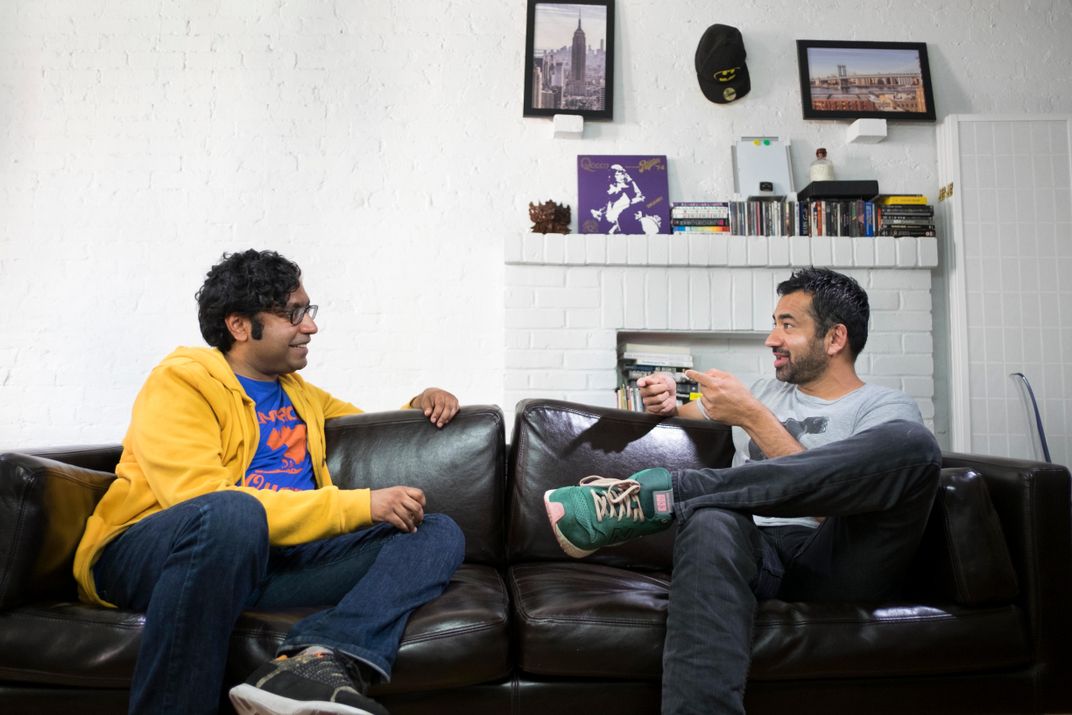‘The Problem with Apu’ Does More Than Pick Apart a ‘Simpsons’ Stereotype
This new documentary tackles Asian representation in media with humor and poise
:focal(1981x816:1982x817)/https://tf-cmsv2-smithsonianmag-media.s3.amazonaws.com/filer/25/e4/25e4968b-e7b2-47e0-a171-a456fb112acf/apu1.jpg)
In the world of American animated television, Matt Groening’s The Simpsons towers, in terms of both its cultural prominence and its improbable longevity. Viewership has steadily declined since the first season (1989-90), when the average episode attracted 30 million pairs of eyeballs. But the show has nevertheless endured through 28 additional years, and Springfield remains a cherished send-up of life in the U.S.
When Indian American comic Hari Kondabolu set out to create his new documentary film, The Problem with Apu, he knew he was taking aim at “an institution in this country.” Specifically, Kondabolu’s movie—now accessible on truTV—delves into the dubious depiction of Kwik-E-Mart owner Apu Nahasapeemapetilon, a first-generation Indian immigrant voiced by a Caucasian and bearing a bogus surname derived from the Sanskrit translation of “bullsh*t.”
For Kondabolu, the story of a misguided cartoon character is just the beginning. “I’m thinking about the future,” he says after an advance screening of his film, sponsored by the Smithsonian Associates and held at the National Museum of Natural History. “I’m using this as an example to have a bigger conversation.”
From a young age, Kondabolu was an admirer of The Simpsons, but as he grew up, he began to take serious issue with the over-the-top accent and shallow dialogue of the program’s sole South Asian character—one of the first, and hence most influential, on mainstream TV.
The humor of Apu stems solely from his voice, Kondabolu contends, a voice first conjured up by actor Hank Azaria as a gag in an early reading of a first script. Kondabolu reveals in the film that the character was originally flagged as specifically non-Indian—the price-gouging Indian convenience store proprietor seemed like too much of a stereotype—but that the creators were persuaded to rethink his race on the basis of Azaria’s outrageous accent.
Throughout the documentary, Kondabolu engages in heart-to-heart dialogues with fellow performers of South Asian heritage—Kal Penn, Aziz Ansari, Aasif Mandvi—who recall being on the receiving end of Apu jokes growing up, and fielding requests to “do the voice.”
White conceptions of what people of Indian descent should sound like have haunted many of the profiled actors across their careers. Finding work as a South Asian American entertainer is not easy. Often, Kondabolu’s interviewees point out, those who are hiring want their characters portrayed in a particular, decidedly non-nuanced way. One of Kal Penn’s early onscreen roles was a guy named Taj Majal; though he was desperate for employment at the time, Penn can’t help but regret having allowed himself to be so flagrantly debased.
In the view of Nafisa Isa, program manager at the Smithsonian Asian Pacific American Center, The Problem with Apu succeeds in leveraging a community’s perspective on a single issue to raise much larger questions. These questions, she says, force us to think about “speaking up against stereotypical representation, and about why representation matters” in the first place. “Because sometimes, given everything that’s happening in the world right now, I think the importance of that can get lost.”
Kondabolu is careful not to despair. In the Internet Age, he sees many ways for entertainers to move forward, paths that simply weren’t available in the days when a handful of major TV stations held control over popular media.
Producers no longer want “the biggest piece of the pie,” Kondabolu notes, “they want a piece of the pie. It’s in their best interest to get a wider range of points of view, and find a niche.” In short, inclusivity isn’t just the right move—it’s a profitable one.

Isa points to the success of recent African American programs as a positive sign of change in the industry. “You see how successful Hidden Figures has been,” she says, “and the anticipation for Black Panther is phenomenal. Empires is still doing really well on Fox. So there’s a huge market for this kind of content.” She is optimistic that a wave of complex Asian American roles will soon be hitting the big screen.
Given this favorable climate, and the affordances of modern technology, Kondabolu adds that it is increasingly incumbent on underrepresented individuals with stories to tell to take the initiative and do so themselves. He points to the example of Issa Rae, whose YouTube series Awkward Black Girl garnered the attention of HBO, ultimately resulting in the creation of her own full-blown TV show, Insecure.
“We have fewer excuses now,” says Kondabolu. “We can buy a decent camera for not very much. Our phones, actually, are higher-quality than a lot of the stuff that was made 20 years ago. We can make art! We can write!”
As Asians and Asian Americans rise through the ranks as their authentic selves, Kondabolu hopes that they will bring an end to the homogenous, white male-dominated production pipelines of the sort responsible for Apu.
“We need to get into those positions,” he says. “We need to be the executives, we need to be the producers, we need to be the writers. We need to own it. Just like it’s important to own land, as a person of color, you need to own the property.”
/https://tf-cmsv2-smithsonianmag-media.s3.amazonaws.com/accounts/headshot/DSC_02399_copy.jpg)


/https://tf-cmsv2-smithsonianmag-media.s3.amazonaws.com/accounts/headshot/DSC_02399_copy.jpg)